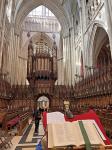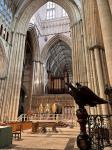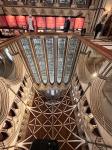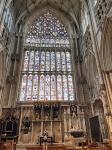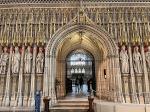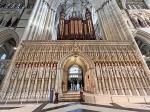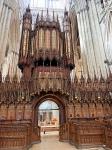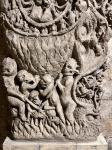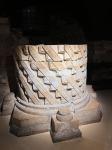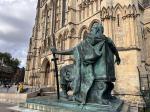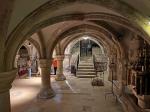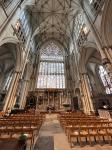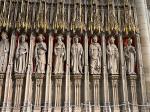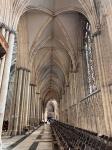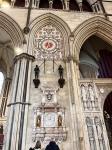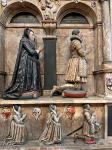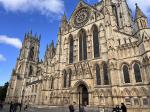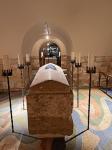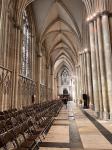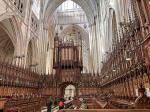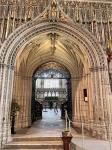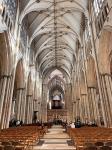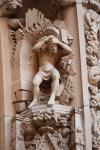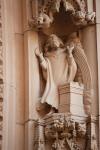Thursday 3rd October 2024 - York Minster
During my walk around York today, whilst looking for ‘the Ghosts in the Garden’, every opportunity I get I like to pop into York Minster and have a quiet look around and marvel at this beautiful Gothic building.
As I had my big camera and lens with me this morning, I wanted to take some images of the stonework and intricate carvings around the great west door. The original carvings around this door were replaced in 2002 due to becoming badly weathered. The new sculptures were carved by the Minster Masons from designs by the sculptor Roy Young. I suspect most people entering the Minster through the Great West Door will miss the carvings as there is so much else to see. It wasn’t until I started taking photographs of the carvings that I realised that they had a story to tell, which soon became apparent, and the story is that of Genesis, the first book of the Old Testament. The carvings show how God creates the heavens and the earth, then creates two individuals, Adam and Eve, as the first man and woman, and places them in the Garden of Eden. In the second chapter, God commanded the man that he is free to eat from any tree, including the tree of life, except from the tree of the knowledge of good and evil. Later, in chapter 3, a serpent, portrayed as a deceptive creature or trickster, convinces Eve to eat the fruit. She then convinces Adam to eat it, whereupon God throws them out and punishes them. Adam was punished with getting what he needs only by sweat and work, and Eve to giving birth in pain. Eve bears two sons, Cain and Abel. Cain works in the garden, and Abel works with meat; they both offer offerings to God one day, and God does not accept Cain's offering but does accept Abel's. This causes Cain to resent Abel, and Cain ends up murdering him. God then curses Cain. Eve bears another son, Seth, to take Abel's place. After many generations of Adam have passed from the lines of Cain and Seth, the world becomes corrupted by human sin, and God wants to wipe out humanity for their wickedness. However, Noah righteous and blameless; so first, he instructs Noah to build an ark and put examples of all the animals on it, seven pairs of every clean animal and one pair of every unclean. Then God sends a great flood to wipe out the rest of the world. When the waters recede, God promises he will never destroy the world with water. It is a fascinating story and interesting to see it depicted in these beautiful carvings around the West door. Above the door are three statues, that on the left a Vavasour holding a block of stone and that on the right a Percy, Lord of the Manor of Tadcaster, holding a block of timber. Interestingly, much of the stone used to build the Minster between the years 1230 – 1422, came from the quarries in Tadcaster. After I finished photographing the sculptures I headed indoors for some quiet reflection. Alas it was very busy with several tour guides showing numerous visitors around the building. I always sit for a few moments in the Naïve looking down towards the alter and the Kings Screen, the sunlight was shining through the stained-glass windows casting glittering patterns over the Minsters floor. I always tend to walk along the North Isle passing the Central Tower and head towards the Quire and follow the stairs down into the Crypt. For some reason I am drawn to the ‘Doomstone’ which depicts the ‘mouth of hell’ and was originally situated in the first Norman minster in the 12th Century. It is quite a scary piece of sculpture. From there I passed the tomb of St William of York who was canonized in 1227. Retracing my footsteps, I left the Crypt and walked up the steps to the Quire. I could spend ages in this part of the Minster, just sitting in one of the pews admiring all the intricate wood panelling and carvings. From here I headed under the organ pipes and popped into the Chapter house, one of the Minster’s architectural gems, the Chapter House contains some of the Minster’s finest carvings and in 1297 was used as the location for the Parliament of King Edward I. The octagonal space dates from the 1280s and its magnificent, vaulted ceiling is supported by timbers in the roof, instead of a central column, which is the earliest example of its kind to use this revolutionary engineering technique. It is always tricky trying to photograph of the ceiling without ending up flat on your back! On safely leaving the Chapter House I headed back to the North & South Transepts to admire the Central Tower the highest point in York and large enough to fit the Leaning Tower of Pisa inside, the Central Tower was originally built between around 1220 and 1253. It was the only part of the current cathedral to have collapsed in 1407 due to soft soil beneath its foundations.
Alongside the North transept is a very informative display entitled ‘Out of the Ashes’ which tells the story of the devastating fire on 9th July 1984 which destroyed the South Transept. This area is dominated by the Five Sisters Window and the only memorial in the country to the women of the British Empire who lost their lives during the First World War. The window, which dates from the mid-1200s, was restored and rededicated between 1923 and 1925 after it was removed during the First World War to protect it during Zeppelin raids. On leaving the Central Tower I headed over to the Minster shop before departing to continue my walk around York looking for the ‘Ghosts in the Gardens’.
|

